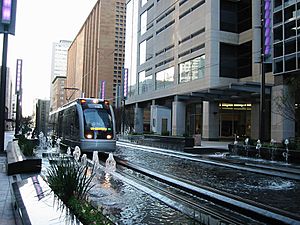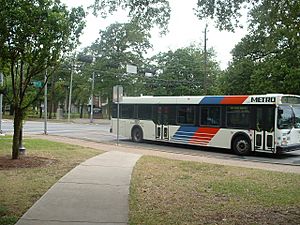Transportation in Houston facts for kids
This is a documentation of the routes, highways, parking requirements, or anything related to transportation in Houston.
Mass transit

The Metropolitan Transit Authority of Harris County, Texas, or METRO, provides public transportation in the form of buses, trolleys, and lift vans.
METRO began running light rail service (METRORail) on January 1, 2004. Currently the track runs approximately 13 miles (20.8 km) from Downtown Houston to the Texas Medical Center and Reliant Park Southbound and to the Northline Mall Northbound. METRO operates an extensive park-and-ride bus system to serve many of Houston's outlying suburban areas. Most of the park-and-ride buses run in barrier-separated high-occupancy-vehicle (HOV) lanes that provide direct service from park-and-ride parking lots to major employment destinations. Prior to the opening of METRORail, Houston was the largest city in the United States without a rail transit system.
Following a successful referendum held locally in 2003, METRO is currently in the beginning design phases of a 10-year expansion plan to add five more sections to connect to the current rail system. An 8.3 mile (13.4 km) expansion has been approved to run the service from the Uptown through Texas Southern University, ending at the University of Houston campus.
In addition, Harris County Transit operates some services in the portion of Clear Lake City in Houston.
Seaport
The Port of Houston is one of the most important ports in the United States, and it is currently second in volume of cargo, right after the Port of South Louisiana. It is also first in the United States in foreign cargo volume. In 2013, more than 229 million total volumes of cargo was handled through the port.
The Port of Galveston is a major hub for cruises and passenger ships. In 2013, 901 thousand passengers were transported through the port, making it the second busiest port in the contiguous United States outside of the South Florida metropolitan area.
Pedestrian travel
Texas Department of Transportation statistics said that in an eight county area including Houston, between 2003 and 2008, around 100 pedestrians died and 1,175 were injured in accidents every year. Mark Seegers, a spokesperson for Harris County commissioner Sylvia Garcia, said in 2009 that "The county does not do sidewalks; it’s not what gets cars [the predominate form of transportation in the Houston area] from point A to point B." Robin Holzer, a transportation advocate with the Citizens' Transportation Coalition, criticized the emphasis on automobiles, saying "The people on foot and bike are trying to go to the same schools and restaurants and shops as people in cars are going to."
In 2005 the Houston-Galveston Area Council identified several communities in Harris County considered to be among the most hazardous to pedestrians. Many of them, including Greenspoint and Gulfton, are located outside of the 610 Loop. In 2009 the lobby group Transportation for America said that the Houston area was the eighth most dangerous area for pedestrians in 2007-2008.
In 2013, Mayor Annise Parker announced the "Houston Complete Street and Transportation Plan", which was an executive order calling for enhanced pedestrian and bicycling modes of transportation when planning new or reconstructing streets. Combined with the "ReBuild Houston" initiative approved by Houston voters in 2010, many new streets have been redesigned using the complete street guidelines.
Houston currently has over 300 miles of City-constructed bike lanes, bike routes, shared lanes, bayou trails and rails-to-trails across a 500 square mile area of Houston.
Demographics by mode of travel
Dan Felstein and Claudia Kolker of the Houston Chronicle said in 1997 that most Houstonians who take public transportation are poor. A 1995 survey concluded that 76% of people riding on local bus lines of the Metropolitan Transit Authority of Harris County (METRO) took the buses because they had no other means of transportation. A 1993 survey concluded that of the people who had stopped riding local bus routes of METRO, 46% had acquired or repaired automobiles. 37% of the respondents said that METRO could not possibly do anything to convince them to ride the buses again.
As of U.S. Census figures current as of 1997, 9% of residents in Harris County did not own automobiles. This figure does not include people who own cars, but do not have enough money to repair the automobiles. As of that year, while the average income of all residents of the county was $41,000, the average income of households without cars was $13,000.
In Harris County, the average one way commute for a person using an automobile was 25 minutes, while the average commute for a person not using an automobile was 44 minutes, a 76% longer duration than the figure for commuters with cars.
As of 1997 many of the lower socio-economic groups, such as the homeless or new-immigrants, rely on bicycles, family members, and neighbors for transportation. Dan Feldstein and Claudia Kolker of the Houston Chronicle said that "ironically, some of the poorest Houstonians have wider transportation options than their middle-class counterparts."
Images for kids
-
Greyhound Lines Houston Station in Midtown
-
Amtrak Houston Station






